Introduction to Max-Heap – Data Structure and Algorithm Tutorials
Last Updated :
11 Mar, 2024
A Max-Heap is defined as a type of Heap Data Structure in which each internal node is greater than or equal to its children.
The heap data structure is a type of binary tree that is commonly used in computer science for various purposes, including sorting, searching, and organizing data.

Introduction to Max-Heap Data Structure
Purpose and Use Cases of Max-Heap:
- Priority Queue: One of the primary uses of the heap data structure is for implementing priority queues.
- Heap Sort: The heap data structure is also used in sorting algorithms.
- Memory Management: The heap data structure is also used in memory management. When a program needs to allocate memory dynamically, it uses the heap data structure to keep track of the available memory.
- Graph Algorithms: The heap data structure is used in various graph algorithms. For example, Dijkstra’s shortest path algorithm uses a heap data structure to keep track of the vertices with the shortest path from the source vertex.
Max-Heap Data structure in Different languages:
A max heap can be implemented using the priority_queue container from the Standard Template Library (STL). The priority_queue container is a type of container adapter that provides a way to store elements in a queue-like data structure in which each element has a priority associated with it.
Syntax: priority_queue<int>maxH;
In Java, a max heap can be implemented using the PriorityQueue class from java.util package. The PriorityQueue class is a priority queue that provides a way to store elements in a queue-like data structure in which each element has a priority associated with it.
Syntax: PriorityQueue maxHeap= new PriorityQueue<>(Comparator.reverseOrder());
In Python, a max heap can be implemented using the heapq module, which provides functions for implementing heaps. Specifically, the heapq module provides a way to create and manipulate heap data structures.
Syntax: heap = []
heapify(heap)
4. Max-Heap in C#
In C#, a max heap can be implemented using the PriorityQueue<T> class from the System.Collections.Generic namespace. The PriorityQueue<T> class is a priority queue that provides a way to store elements in a queue-like data structure in which each element has a priority associated with it.
Syntax: var maxHeap = new PriorityQueue<int>((a, b) => b - a);
A max heap is a binary tree where every node has a value greater than or equal to its children. In JavaScript, you can implement a max heap using an array, where the first element represents the root node, and the children of a node at index i are located at indices 2i+1 and 2i+2.
Syntax: const miaxHeap = new MaxHeap();
| |
Min Heap |
Max Heap |
| 1. |
In a Min-Heap the key present at the root node must be less than or equal to among the keys present at all of its children. |
In a Max-Heap the key present at the root node must be greater than or equal to among the keys present at all of its children. |
| 2. |
In a Min-Heap the minimum key element present at the root. |
In a Max-Heap the maximum key element present at the root. |
| 3. |
A Min-Heap uses the ascending priority. |
A Max-Heap uses the descending priority. |
| 4. |
In the construction of a Min-Heap, the smallest element has priority. |
In the construction of a Max-Heap, the largest element has priority. |
| 5. |
In a Min-Heap, the smallest element is the first to be popped from the heap. |
In a Max-Heap, the largest element is the first to be popped from the heap. |
Internal Implementation of Max-Heap Data Structure:
A Min heap is typically represented as an array.
- The root element will be at Arr[0].
- For any ith node Arr[i].
- left child is stored at index 2i+1
- Right child is stored at index 2i+2
- Parent is stored at index floor((i-1)/2)
The Internal Implementation of the Max-Heap require 3 major steps:
- Insertion: To insert a new element into the heap, it is added to the end of the array and then “bubbled up” until it satisfies the heap property.
- Deletion: To delete the maximum element (the root of the heap), the last element in the array is swapped with the root, and the new root is “bubbled down” until it satisfies the heap property.
- Heapify: A heapify operation can be used to create a max heap from an unsorted array.
Operations on Max-heap Data Structure and their Implementation:
Here are some common operations that can be performed on a Heap Data Structure data structure,
Elements can be inserted to the heap following a similar approach as discussed above for deletion. The idea is to:
- First increase the heap size by 1, so that it can store the new element.
- Insert the new element at the end of the Heap.
- This newly inserted element may distort the properties of Heap for its parents. So, in order to keep the properties of Heap, heapify this newly inserted element following a bottom-up approach.
Illustration:
Suppose the Heap is a Max-Heap as:
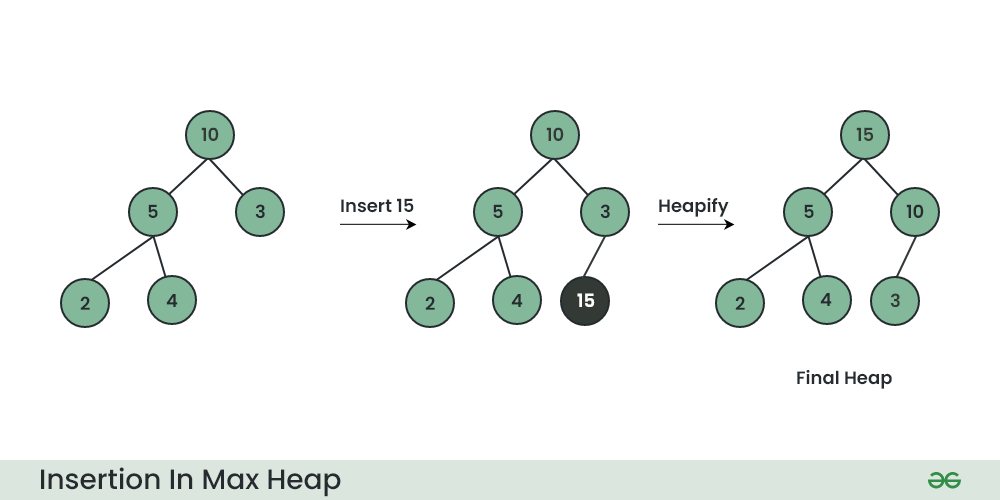
Insertion in Max heap
Implementation of insertion operation in Max-Heap:
C++
#include <iostream>
using namespace std;
#define MAX 1000 // Max size of Heap
void heapify(int arr[], int n, int i)
{
int parent = (i - 1) / 2;
if (arr[parent] > 0) {
if (arr[i] > arr[parent]) {
swap(arr[i], arr[parent]);
heapify(arr, n, parent);
}
}
}
void insertNode(int arr[], int& n, int Key)
{
n = n + 1;
arr[n - 1] = Key;
heapify(arr, n, n - 1);
}
void printArray(int arr[], int n)
{
for (int i = 0; i < n; ++i)
cout << arr[i] << " ";
cout << "\n";
}
int main()
{
int arr[MAX] = { 10, 5, 3, 2, 4 };
int n = 5;
int key = 15;
insertNode(arr, n, key);
printArray(arr, n);
return 0;
}
|
Java
public class insertionHeap {
static void heapify(int[] arr, int n, int i)
{
int parent = (i - 1) / 2;
if (arr[parent] > 0) {
if (arr[i] > arr[parent]) {
int temp = arr[i];
arr[i] = arr[parent];
arr[parent] = temp;
heapify(arr, n, parent);
}
}
}
static int insertNode(int[] arr, int n, int Key)
{
n = n + 1;
arr[n - 1] = Key;
heapify(arr, n, n - 1);
return n;
}
static void printArray(int[] arr, int n)
{
for (int i = 0; i < n; ++i)
System.out.println(arr[i] + " ");
System.out.println();
}
public static void main(String args[])
{
int MAX = 1000;
int[] arr = new int[MAX];
arr[0] = 10;
arr[1] = 5;
arr[2] = 3;
arr[3] = 2;
arr[4] = 4;
int n = 5;
int Key = 15;
n = insertNode(arr, n, Key);
printArray(arr, n);
}
}
|
C#
using System;
public class insertionHeap {
static void heapify(int[] arr, int n, int i) {
int parent = (i - 1) / 2;
if (arr[parent] > 0) {
if (arr[i] > arr[parent]) {
int temp = arr[i];
arr[i] = arr[parent];
arr[parent] = temp;
heapify(arr, n, parent);
}
}
}
static int insertNode(int[] arr, int n, int Key) {
n = n + 1;
arr[n - 1] = Key;
heapify(arr, n, n - 1);
return n;
}
static void printArray(int[] arr, int n) {
for (int i = 0; i < n; ++i)
Console.WriteLine(arr[i] + " ");
Console.WriteLine("");
}
public static void Main(string[] args) {
int MAX = 1000;
int[] arr = new int[MAX];
arr[0] = 10;
arr[1] = 5;
arr[2] = 3;
arr[3] = 2;
arr[4] = 4;
int n = 5;
int Key = 15;
n = insertNode(arr, n, Key);
printArray(arr, n);
}
}
|
Javascript
let MAX = 1000;
function heapify(arr, n, i)
{
let parent = Math.floor((i-1)/2);
if (arr[parent] >= 0) {
if (arr[i] > arr[parent]) {
let temp = arr[i];
arr[i] = arr[parent];
arr[parent] = temp;
heapify(arr, n, parent);
}
}
}
function insertNode(arr, n, Key)
{
n = n + 1;
arr[n - 1] = Key;
heapify(arr, n, n - 1);
return n;
}
function printArray(arr, n)
{
for (let i = 0; i < n; ++i)
console.log(arr[i] + " ");
console.log("</br>");
}
let arr = [ 10, 5, 3, 2, 4 ];
let n = arr.length;
let key = 15;
n = insertNode(arr, n, key);
printArray(arr, n);
|
Python3
def heapify(arr, n, i):
parent = int(((i-1)/2))
if arr[parent] > 0:
if arr[i] > arr[parent]:
arr[i], arr[parent] = arr[parent], arr[i]
heapify(arr, n, parent)
def insertNode(arr, key):
global n
n += 1
arr.append(key)
heapify(arr, n, n-1)
def printArr(arr, n):
for i in range(n):
print(arr[i], end=" ")
arr = [10, 5, 3, 2, 4, 1, 7]
n = 7
key = 15
insertNode(arr, key)
printArr(arr, n)
|
Time Complexity: O(log(n)) (where n is no of elements in the heap)
Auxiliary Space: O(n)
Deleting an element at any intermediary position in the heap can be costly, so we can simply replace the element to be deleted with the last element and delete the last element of the Heap.
- Replace the root or element to be deleted with the last element.
- Delete the last element from the Heap.
- Since the last element is now placed at the position of the root node. So, it may not follow the heap property. Therefore, heapify the last node placed at the position of the root.
Illustration:
Suppose the Heap is a Max-Heap as:
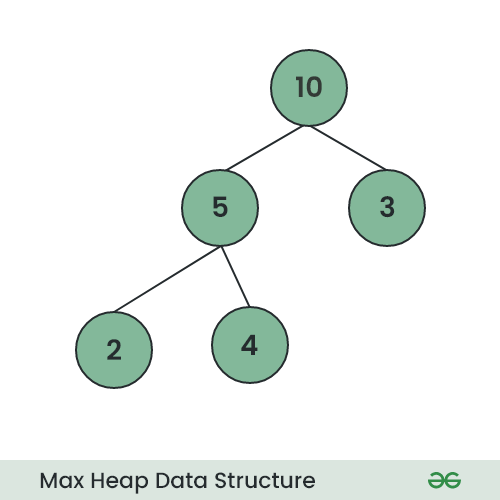
Max Heap Data Structure
The element to be deleted is root, i.e. 10.
Process:
The last element is 4.
Step 1: Replace the last element with root, and delete it.
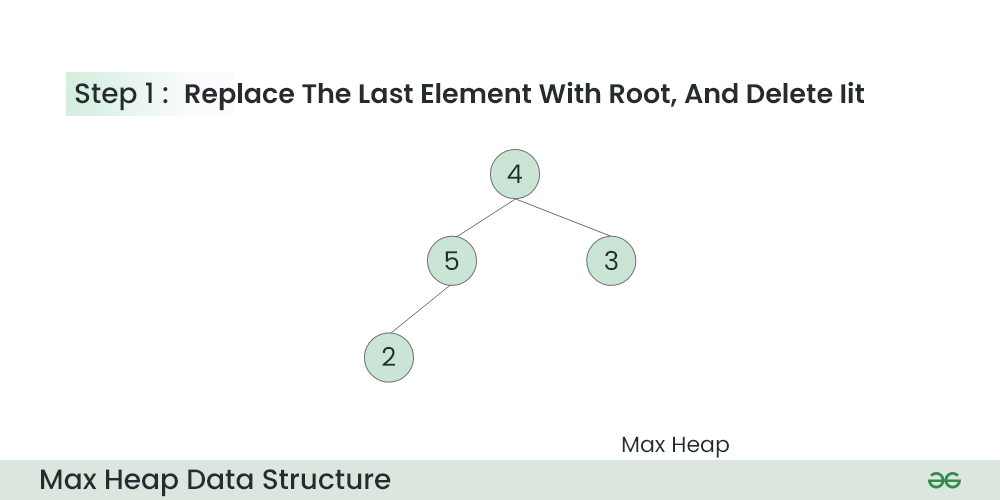
Max Heap
Step 2: Heapify root.
Final Heap:
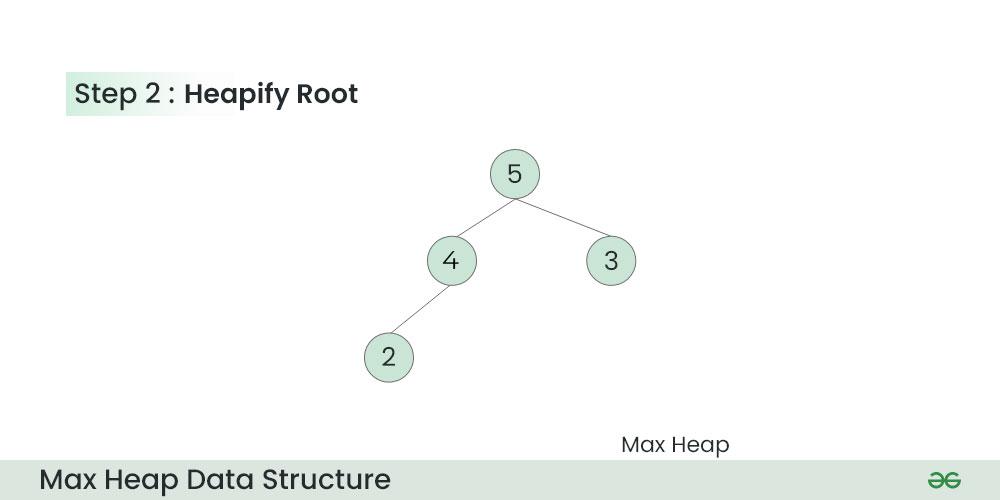
Max Heap
Implementation of Deletion operation in Max-Heap:
C++
#include <iostream>
using namespace std;
void heapify(int arr[], int n, int i)
{
int largest = i;
int l = 2 * i + 1;
int r = 2 * i + 2;
if (l < n && arr[l] > arr[largest])
largest = l;
if (r < n && arr[r] > arr[largest])
largest = r;
if (largest != i) {
swap(arr[i], arr[largest]);
heapify(arr, n, largest);
}
}
void deleteRoot(int arr[], int& n)
{
int lastElement = arr[n - 1];
arr[0] = lastElement;
n = n - 1;
heapify(arr, n, 0);
}
void printArray(int arr[], int n)
{
for (int i = 0; i < n; ++i)
cout << arr[i] << " ";
cout << "\n";
}
int main()
{
int arr[] = { 10, 5, 3, 2, 4 };
int n = sizeof(arr) / sizeof(arr[0]);
deleteRoot(arr, n);
printArray(arr, n);
return 0;
}
|
Java
public class deletionHeap {
static void heapify(int arr[], int n, int i)
{
int largest = i;
int l = 2 * i + 1;
int r = 2 * i + 2;
if (l < n && arr[l] > arr[largest])
largest = l;
if (r < n && arr[r] > arr[largest])
largest = r;
if (largest != i) {
int swap = arr[i];
arr[i] = arr[largest];
arr[largest] = swap;
heapify(arr, n, largest);
}
}
static int deleteRoot(int arr[], int n)
{
int lastElement = arr[n - 1];
arr[0] = lastElement;
n = n - 1;
heapify(arr, n, 0);
return n;
}
static void printArray(int arr[], int n)
{
for (int i = 0; i < n; ++i)
System.out.print(arr[i] + " ");
System.out.println();
}
public static void main(String args[])
{
int arr[] = { 10, 5, 3, 2, 4 };
int n = arr.length;
n = deleteRoot(arr, n);
printArray(arr, n);
}
}
|
C#
using System;
public class deletionHeap
{
static void heapify(int []arr, int n, int i)
{
int largest = i;
int l = 2 * i + 1;
int r = 2 * i + 2;
if (l < n && arr[l] > arr[largest])
largest = l;
if (r < n && arr[r] > arr[largest])
largest = r;
if (largest != i)
{
int swap = arr[i];
arr[i] = arr[largest];
arr[largest] = swap;
heapify(arr, n, largest);
}
}
static int deleteRoot(int []arr, int n)
{
int lastElement = arr[n - 1];
arr[0] = lastElement;
n = n - 1;
heapify(arr, n, 0);
return n;
}
static void printArray(int []arr, int n)
{
for (int i = 0; i < n; ++i)
Console.Write(arr[i] + " ");
Console.WriteLine();
}
public static void Main()
{
int []arr = { 10, 5, 3, 2, 4 };
int n = arr.Length;
n = deleteRoot(arr, n);
printArray(arr, n);
}
}
|
Javascript
<script>
function heapify(arr, n, i)
{
let largest = i;
let l = 2 * i + 1;
let r = 2 * i + 2;
if (l < n && arr[l] > arr[largest])
largest = l;
if (r < n && arr[r] > arr[largest])
largest = r;
if (largest != i)
{
let swap = arr[i];
arr[i] = arr[largest];
arr[largest] = swap;
heapify(arr, n, largest);
}
}
function deleteRoot(arr, n)
{
let lastElement = arr[n - 1];
arr[0] = lastElement;
n = n - 1;
heapify(arr, n, 0);
return n;
}
function printArray(arr, n)
{
for (let i = 0; i < n; ++i)
document.write(arr[i] + " ");
document.write("</br>");
}
let arr = [ 10, 5, 3, 2, 4 ];
let n = arr.length;
n = deleteRoot(arr, n);
printArray(arr, n);
</script>
|
Python3
def heapify(arr, n, i):
largest = i
l = 2 * i + 1
r = 2 * i + 2
if (l < n and arr[l] > arr[largest]):
largest = l
if (r < n and arr[r] > arr[largest]):
largest = r
if (largest != i):
arr[i],arr[largest]=arr[largest],arr[i]
heapify(arr, n, largest)
def deleteRoot(arr):
global n
lastElement = arr[n - 1]
arr[0] = lastElement
n = n - 1
heapify(arr, n, 0)
def printArray(arr, n):
for i in range(n):
print(arr[i],end=" ")
print()
if __name__ == '__main__':
arr = [ 10, 5, 3, 2, 4 ]
n = len(arr)
deleteRoot(arr)
printArray(arr, n)
|
Time complexity: O(log n) where n is no of elements in the heap
Auxiliary Space: O(n)
3. Peek operation on Max-heap Data Structure:
To access the maximum element (i.e., the root of the heap), the value of the root node is returned. The time complexity of peek in a max heap is O(1).

Peak Element Of Max- Heap
Implementation of Peek operation in Max-Heap:
C++
#include <iostream>
#include <queue>
int main() {
std::priority_queue<int> maxHeap;
maxHeap.push(9);
maxHeap.push(8);
maxHeap.push(7);
maxHeap.push(6);
maxHeap.push(5);
maxHeap.push(4);
maxHeap.push(3);
maxHeap.push(2);
maxHeap.push(1);
int peakElement = maxHeap.top();
std::cout << "Peak element: " << peakElement << std::endl;
return 0;
}
|
Java
import java.util.PriorityQueue;
public class GFG {
public static void main(String[] args) {
PriorityQueue<Integer> maxHeap = new PriorityQueue<>((a, b) -> b - a);
maxHeap.add(9);
maxHeap.add(8);
maxHeap.add(7);
maxHeap.add(6);
maxHeap.add(5);
maxHeap.add(4);
maxHeap.add(3);
maxHeap.add(2);
maxHeap.add(1);
int peakElement = maxHeap.peek();
System.out.println("Peak element: " + peakElement);
}
}
|
C#
using System;
using System.Collections.Generic;
public class GFG {
public static void Main() {
var maxHeap = new PriorityQueue<int>();
maxHeap.Enqueue(9);
maxHeap.Enqueue(8);
maxHeap.Enqueue(7);
maxHeap.Enqueue(6);
maxHeap.Enqueue(5);
maxHeap.Enqueue(4);
maxHeap.Enqueue(3);
maxHeap.Enqueue(2);
maxHeap.Enqueue(1);
int peakElement = maxHeap.Peek();
Console.WriteLine("Peak element: " + peakElement);
}
}
class PriorityQueue<T> where T : IComparable<T> {
private List<T> heap;
public PriorityQueue() {
this.heap = new List<T>();
}
public int Count {
get { return this.heap.Count; }
}
public void Enqueue(T item) {
this.heap.Add(item);
this.BubbleUp(this.heap.Count - 1);
}
public T Dequeue() {
T item = this.heap[0];
int lastIndex = this.heap.Count - 1;
this.heap[0] = this.heap[lastIndex];
this.heap.RemoveAt(lastIndex);
this.BubbleDown(0);
return item;
}
public T Peek() {
return this.heap[0];
}
private void BubbleUp(int index) {
while (index > 0) {
int parentIndex = (index - 1) / 2;
if (this.heap[parentIndex].CompareTo(this.heap[index]) >= 0) {
break;
}
Swap(parentIndex, index);
index = parentIndex;
}
}
private void BubbleDown(int index) {
while (index < this.heap.Count) {
int leftChildIndex = index * 2 + 1;
int rightChildIndex = index * 2 + 2;
int largestChildIndex = index;
if (leftChildIndex < this.heap.Count && this.heap[leftChildIndex].CompareTo(this.heap[largestChildIndex]) > 0) {
largestChildIndex = leftChildIndex;
}
if (rightChildIndex < this.heap.Count && this.heap[rightChildIndex].CompareTo(this.heap[largestChildIndex]) > 0) {
largestChildIndex = rightChildIndex;
}
if (largestChildIndex == index) {
break;
}
Swap(largestChildIndex, index);
index = largestChildIndex;
}
}
private void Swap(int i, int j) {
T temp = this.heap[i];
this.heap[i] = this.heap[j];
this.heap[j] = temp;
}
}
|
Javascript
class MaxHeap {
constructor() {
this.heap = [];
}
push(item) {
this.heap.push(item);
this.bubbleUp(this.heap.length - 1);
}
pop() {
let item = this.heap[0];
let lastIndex = this.heap.length - 1;
this.heap[0] = this.heap[lastIndex];
this.heap.pop();
this.bubbleDown(0);
return item;
}
peak() {
return this.heap[0];
}
bubbleUp(index) {
while (index > 0) {
let parentIndex = Math.floor((index - 1) / 2);
if (this.heap[parentIndex] >= this.heap[index]) {
break;
}
this.swap(parentIndex, index);
index = parentIndex;
}
}
bubbleDown(index) {
while (index < this.heap.length) {
let leftChildIndex = index * 2 + 1;
let rightChildIndex = index * 2 + 2;
let largestChildIndex = index;
if (leftChildIndex < this.heap.length && this.heap[leftChildIndex] > this.heap[largestChildIndex]) {
largestChildIndex = leftChildIndex;
}
if (rightChildIndex < this.heap.length && this.heap[rightChildIndex] > this.heap[largestChildIndex]) {
largestChildIndex = rightChildIndex;
}
if (largestChildIndex === index) {
break;
}
this.swap(largestChildIndex, index);
index = largestChildIndex;
}
}
swap(i, j) {
let temp = this.heap[i];
this.heap[i] = this.heap[j];
this.heap[j] = temp;
}
}
let maxHeap = new MaxHeap();
maxHeap.push(9);
maxHeap.push(8);
maxHeap.push(7);
maxHeap.push(6);
maxHeap.push(5);
maxHeap.push(4);
maxHeap.push(3);
maxHeap.push(2);
maxHeap.push(1);
let peakElement = maxHeap.peak();
console.log("Peak element: " + peakElement);
|
Python3
import heapq
max_heap = [1,2,3,4,5,6,7,8,9]
heapq.heapify(max_heap)
peak_element = heapq.nlargest(1, max_heap)[0]
print("Peak element:", peak_element)
|
Time complexity:
- In a max heap implemented using an array or a list, the peak element can be accessed in constant time, O(1), as it is always located at the root of the heap.
- In a max heap implemented using a binary tree, the peak element can also be accessed in O(1) time, as it is always located at the root of the tree.
Auxiliary Space: O(n)
4. Heapify operation on Max-heap Data Structure:
A heapify operation can be used to create a max heap from an unsorted array. This is done by starting at the last non-leaf node and repeatedly performing the “bubble down” operation until all nodes satisfy the heap property. The time complexity of heapify in a max heap is O(n).
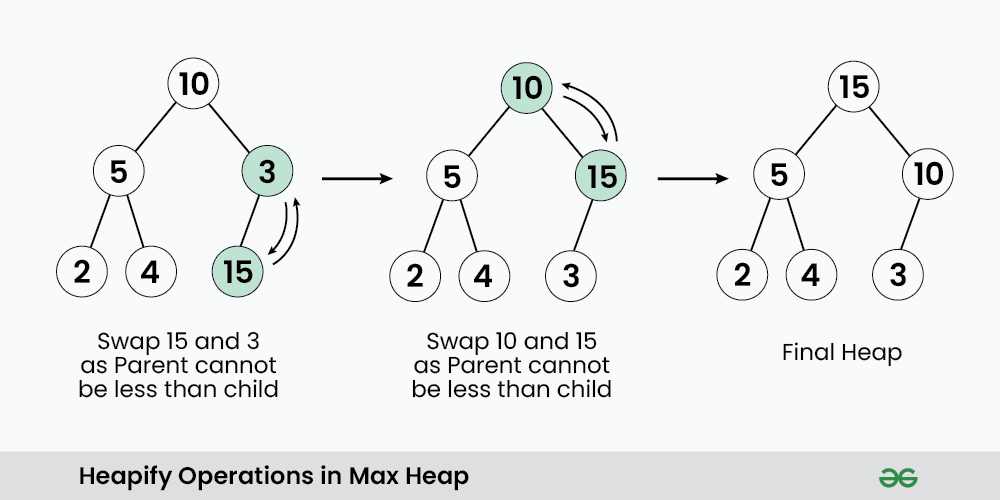
Heapify Operations in Max-Heap
5. Search operation on Max-heap Data Structure:
To search for an element in the max heap, a linear search can be performed over the array that represents the heap. However, the time complexity of a linear search is O(n), which is not efficient. Therefore, searching is not a commonly used operation in a max heap.
Here’s an example code that shows how to search for an element in a max heap using std::find():
C++
#include <iostream>
#include <queue> // for std::priority_queue
using namespace std;
int main() {
std::priority_queue<int> max_heap;
max_heap.push(10);
max_heap.push(9);
max_heap.push(8);
max_heap.push(6);
max_heap.push(4);
int element = 6;
bool found = false;
std::priority_queue<int> temp = max_heap;
while (!temp.empty()) {
if (temp.top() == element) {
found = true;
break;
}
temp.pop();
}
if (found) {
std::cout << "Element found in the max heap." << std::endl;
} else {
std::cout << "Element not found in the max heap." << std::endl;
}
return 0;
}
|
Java
import java.util.PriorityQueue;
public class GFG {
public static void main(String[] args) {
PriorityQueue<Integer> maxHeap = new PriorityQueue<>((a, b) -> b - a);
maxHeap.add(3);
maxHeap.offer(1);
maxHeap.offer(4);
maxHeap.offer(1);
maxHeap.offer(6);
int element = 6;
boolean found = false;
PriorityQueue<Integer> temp = new PriorityQueue<>(maxHeap);
while (!temp.isEmpty()) {
if (temp.poll() == element) {
found = true;
break;
}
}
if (found) {
System.out.println("Element found in the max heap.");
} else {
System.out.println("Element not found in the max heap.");
}
}
}
|
C#
using System;
using System.Collections.Generic;
class Program {
static void Main(string[] args) {
PriorityQueue<int> maxHeap = new PriorityQueue<int>();
maxHeap.Enqueue(10);
maxHeap.Enqueue(9);
maxHeap.Enqueue(8);
maxHeap.Enqueue(6);
maxHeap.Enqueue(4);
int element = 6;
bool found = false;
PriorityQueue<int> temp = new PriorityQueue<int>(maxHeap);
while (temp.Count > 0) {
if (temp.Peek() == element) {
found = true;
break;
}
temp.Dequeue();
}
if (found) {
Console.WriteLine("Element found in the max heap.");
} else {
Console.WriteLine("Element not found in the max heap.");
}
}
}
class PriorityQueue<T> where T : IComparable<T> {
private List<T> heap = new List<T>();
public void Enqueue(T item) {
heap.Add(item);
int child = heap.Count - 1;
while (child > 0) {
int parent = (child - 1) / 2;
if (heap[child].CompareTo(heap[parent]) > 0) {
T tmp = heap[child];
heap[child] = heap[parent];
heap[parent] = tmp;
child = parent;
} else {
break;
}
}
}
public T Dequeue() {
int last = heap.Count - 1;
T frontItem = heap[0];
heap[0] = heap[last];
heap.RemoveAt(last);
last--;
int parent = 0;
while (true) {
int leftChild = parent * 2 + 1;
if (leftChild > last) {
break;
}
int rightChild = leftChild + 1;
if (rightChild <= last && heap[leftChild].CompareTo(heap[rightChild]) < 0) {
leftChild = rightChild;
}
if (heap[parent].CompareTo(heap[leftChild]) < 0) {
T tmp = heap[parent];
heap[parent] = heap[leftChild];
heap[leftChild] = tmp;
parent = leftChild;
} else {
break;
}
}
return frontItem;
}
public T Peek() {
return heap[0];
}
public int Count {
get {
return heap.Count;
}
}
}
|
Javascript
const maxHeap = new PriorityQueue((a, b) => b - a);
maxHeap.add(3);
maxHeap.add(1);
maxHeap.add(4);
maxHeap.add(1);
maxHeap.add(6);
const element = 6;
let found = false;
const temp = new PriorityQueue(maxHeap);
while (!temp.isEmpty()) {
if (temp.poll() === element) {
found = true;
break;
}
}
if (found) {
console.log("Element found in the max heap.");
} else {
console.log("Element not found in the max heap.");
}
|
Python3
import heapq
max_heap = [10, 8, 7, 6, 5, 3, 2, 1]
heapq._heapify_max(max_heap)
element = 6
found = False
temp = list(max_heap)
while temp:
if heapq._heappop_max(temp) == element:
found = True
break
if found:
print("Element found in the max heap.")
else:
print("Element not found in the max heap.")
|
Output
Element found in the max heap.
Time complexity: O(n), where n is the size of the heap.
Auxiliary Space: O(n),
Applications of Max-Heap Data Structure:
- Heapsort algorithm: The heap data structure is the basis for the heapsort algorithm, which is an efficient sorting algorithm with a worst-case time complexity of O(n log n). The heapsort algorithm is used in various applications, including database indexing and numerical analysis.
- Memory management: The heap data structure is used in memory management systems to allocate and deallocate memory dynamically. The heap is used to store the memory blocks, and the heap data structure is used to efficiently manage the memory blocks and allocate them to programs as needed.
- Graph algorithms: The heap data structure is used in various graph algorithms, including Dijkstra’s algorithm, Prim’s algorithm, and Kruskal’s algorithm. These algorithms require efficient priority queue implementation, which can be achieved using the heap data structure.
- Job scheduling: The heap data structure is used in job scheduling algorithms, where tasks are scheduled based on their priority or deadline. The heap data structure allows efficient access to the highest-priority task, making it a useful data structure for job scheduling applications.
- Efficiently maintain the maximum value: A max heap allows constant-time access to the maximum element in the heap, which makes it useful in applications where the maximum element needs to be found quickly.
- Efficient insert and delete operations: The insert and delete operations in a max heap have a time complexity of O(log n), which makes them efficient for large collections of elements.
- Priority Queues: A max heap can be used to implement a priority queue, which is useful in many applications such as job scheduling, task prioritization, and event-driven simulation.
- Sorting: A max heap can be used to implement heapsort, which is an efficient sorting algorithm that has a worst-case time complexity of O(n log n).
- Space efficiency: A max heap can be implemented as an array, which requires less memory compared to other data structures such as a binary search tree or a linked list.
Max heap data structure is a useful and efficient tool for maintaining and manipulating collections of elements, particularly when the maximum element needs to be accessed quickly or when elements need to be sorted or prioritized.
Share your thoughts in the comments
Please Login to comment...